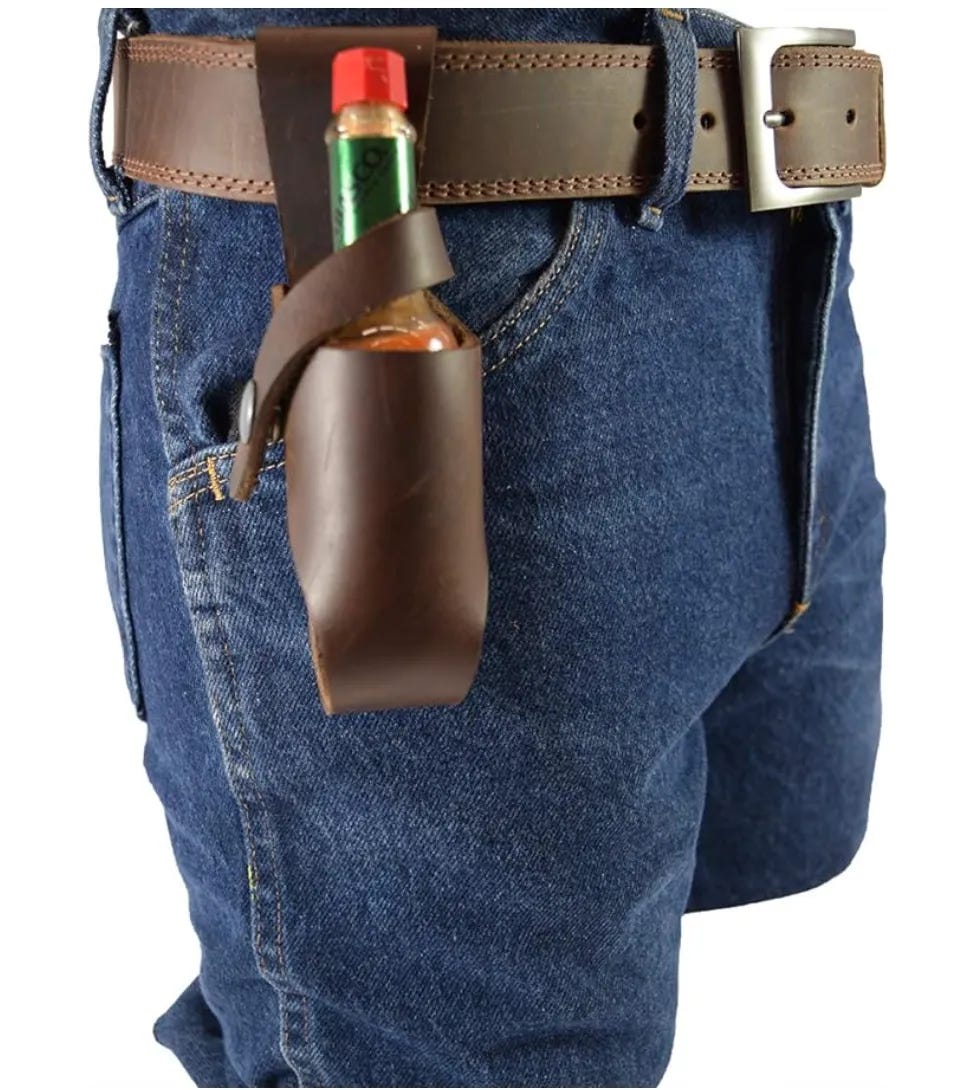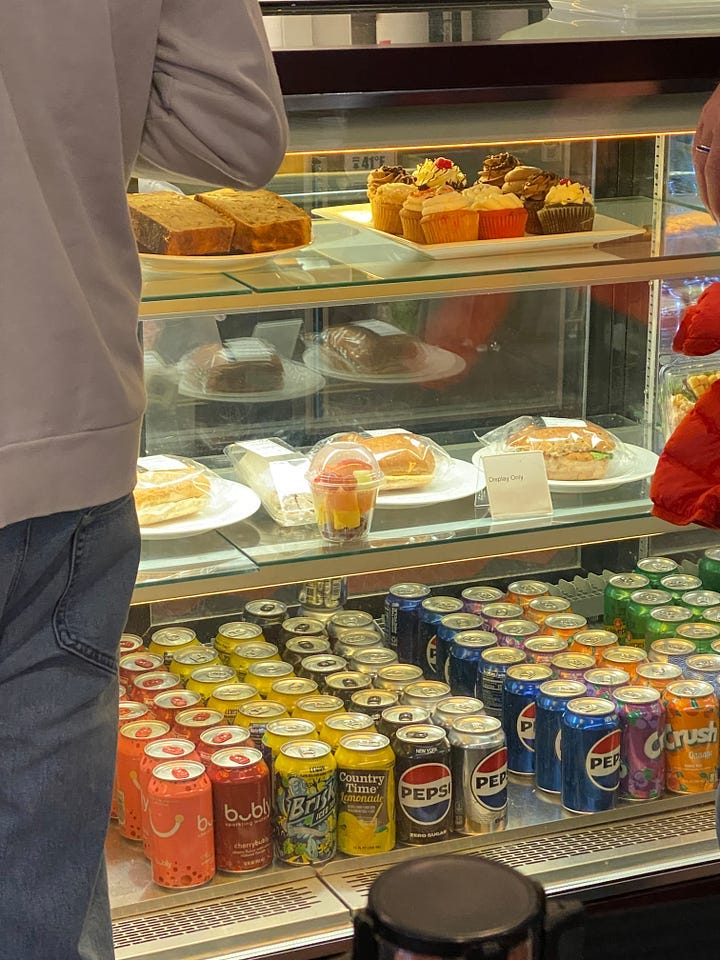The LGBrieTQ Community
The Great Midwest Cheese Duel, The LGBrieTQ community, Eating in museums, Eating and reading at the bar, Hot sauce state battles, Queer billiards, Changing tastebuds, The Capertini, and more!
Hello!
Welcome back to another Drink Seco newsletter!
I’ll start the newsletter with these two wonderful images because you guys know how much I love oysters. If there’s a will there’s a way!
This week:
The Great Midwest Cheese Duel of 1935
Why cheese is inherently Queer
How the Queers Stole Billiards
Eating at the museum
Eating at the bar
Reading at the bar
Introducing the Capertini
What hot sauce is the most popular in your state?
The Great Midwest Cheese Duel of 1935:
We’re all familiar with the famous American duels in history, right? Alexander Hamilton and Aaron Burr, the great Midwest cheese duel... You know, the classics.
The Great Midwest Cheese Duel began in the winter of 1935 when a doctor in Iowa, prescribed an odd medicine to a sick farmer’s wife: Limburger cheese. The doctor figured the heavily aromatic cheese would help clear the woman's clogged sinuses. He put the cheese order through to Monroe, Wisconsin, (the Limburger capital at the time Swiss cheesemakers arrived there in 1845).
Monroe's postmaster, John Burkhard, approved the delivery and sent it on its way. But the mail carrier in Iowa, who delivered the cheese was so disgusted by the smell in his bag that he refused to deliver it. Independent’s postmaster Miller agreed.
“Burkhard took it personally; to insult Limburger is to insult not just Monroe, but all of Wisconsin and its proud cheese heritage. So Burkhard rewrapped the package and sent it back to Iowa. Miller promptly returned it to Wisconsin. War was brewing.”
“This was the core of the original dispute: Could a block of Limburger be a threat to public health, a malodorous menace to society? More to the point, could you send it in the mail?”
The site of the battle was chosen as a neutral ground, roughly halfway between their hometowns, the fancy Hotel Julien.
The chosen weapon? Cheese.
“Burkhard challenged postmaster Miller to a "cheese-smelling duel"-if Miller could sit at a table and not wretch from the stench of freshly-cut Limburger, then he would never again raise a stink about Wisconsin and its cheese.
As Burkhard prepared to push the slab of cheese over to Miller, he offered Miller a clothespin and a gas mask. But Miller just shook his head and meekly surrendered. "I won't need that clothespin," he lamented, "I haven't any sense of smell."
The crowd gasped. The battle was over before it began. Burkhard was immediately declared the winner, and Miller had to agree to allow any and all Wisconsin cheese safe passage through Iowa's postal routes.
On October 4, 1935, Cheese Day made its triumphant return to Monroe. Some 50,000 people showed up to watch the parade and eat copious amounts of the good—and stinky—stuff.”
So good. Long live stinky cheese!
Why cheese is inherently Queer:
I read this headline in Eater written by Nat Belkov and immediately had to find out more. In Pride Month I wrote a newsletter titled ‘What Makes a Dish Queer?’ so this article felt like a natural extension of that exploration.
Belkov writes “Confusion around my gender identity was the little alarm that would go off every once in a while just to be snoozed again and again, over and over, for nearly two and a half decades. I only finally decided to do something about it when I started working with cheese.”
Cheese is weird, and therefore, really only attracts people that see that weird as wonderful.
Belkov explains “A lot of people in cheese identify as queer. But that’s only one piece of the puzzle.”
“Cheesemaking requires a willingness to take risks and trust the process — just like navigating queer existence”.
The article is a really beautiful look at Queerness in an industry I didn’t realize it was thriving in. This isn’t to say there still isn’t room for improvement, intersectionality has also been an area of struggle. The Cheese Culture Coalition, of which James sits on the board, is actively establishing systems of accountability with the goal of unlocking more access and equity for BIPOC individuals in cheese.
“It’s a beautiful thing to be able to ask the question of ourselves: What happens if we try something else? It suggests that we’re all still learning.”
There is even an LGBrieTQ Community and ‘Chesbians’ that support each other in business and share their love of cheese.
In a Vice Article, Melissa Kravitz asked some Queer cheesemongers what the gayest cheese was. Some of the answers:
“Mimolette. It looks like a cantaloupe or a cannonball, but it’s actually cheese. It’s a bright orange, fantastic, over-the-top thing with an odd rind. The shape is so weird. It’s a surprise, a flamingo of cheeses.” –Cara Warren
“The queerest cheese is definitely Feta Lesbos, from the island of Lesbos. The Lesbian sheep—yes, this is the real term for sheep from Lesbos—produce a rich four- to 18-month brined feta distributed in the US by Essex Cheese. Lesbos is the only Greek island to hold a PDO [Protected Designation of Origin] for feta, so feel free to eat copious amounts of this cheese with your queer friends knowing these Lesbian sheep are in good hands.” –Hannah Morrow
“Lesbians love stinky cheese.” –Abby Pfunder
For Belkov, blue-veined cheddars come to mind. These cheeses occur when air finds its way into the micro-crevices that often form in the rinds of well-aged clothbound cheddar truckles. Oxygen then activates mold within — the same strain that’s inoculated into any blue cheese… As they age, these tangy, crystalline-studded cheddars grow delicious striations of peppery blue.” Given the space to breathe and grow, they turn into something beautiful, delicious, and wonderful. But like Queerness, “many cheesemongers find their customers have a hard time accepting this blue veining; while perfectly natural and safe to eat, they may see it as grotesque — a flaw that renders the entire product undesirable.” Their loss.”
How the Queers Stole Billiards:
Sarah Brooks first joined a male-dominated league of over 50 teams by founding the one queer and femme team, named the C U Next Tuesdays.
As with many traditional bar and sports spaces, Sarah found billiards was completely macho-male-dominated and it was hard to get through a night without having a man explain how to hold a pool stick or hit on you.
For over a year now, she has organized a local Louisiana women and trans pool tournament. Each of the players has their own stories about how pool became their monthly, weekly, or even daily habit, and why they have been drawn to the tournament.
“The first round is split between Big Daddy’s and its more fashionable neighbor, Anna’s. Once those initial eight matchups are complete, the rest of the tournament’s events unfold in the dimly lit comfort of Big Daddy’s. Tucked in the Marigny neighborhood, the gay bar has been open since the early ’90s; many of its original regulars are still holding court 30 years later.”
Sarah has found the environment is totally different, people aren’t afraid to make mistakes, they feel comfortable, and they’re also talented.
“It’s a beautiful thing to create, from the ground up, spaces that are for gay, queer, trans people and women; it’s OK to have something just for us,”
Eating at the Museum:
Adriana Gallo, an author and researcher who often writes for MOLD Magazine released a wonderful zine commissioned by Alicia Kennedy which “works through a speculative typology of museum cafes, the history of museum dining, and prods at the problematics of institutional relationships to food and the holes in curatorial logic when it comes to encountering the comestible.” Download it here.

The zine attempts to categorize the range of museum dining options based on intersections of atmosphere, culinary offerings, and price. These categories are:
The Fine Dining Restaurant
The Themed Restaurant
The Café
The Food Court
It talks about who museum restaurants are for, the purpose they serve, and by extension, who museums are for.
“As museum prices sky-rocket, the steep markup of basic food items feels increasingly smug. Even after leveraging a student ID, a credit card with a “culture pass”, or some sort of community hours discount, low blood sugar visitors are still subjected to the price of an $8 for a stale cookie in order to continue participating and circulating. Or in the case of families, a choice between a visit-ending tantrum and a moment to refuel that essentially constitutes a second admission in price. In some cases, the cafe is one of a few moments in which the majority is attempted to be quite literally catered to.”
Eating at the bar:
I will always sing the praises of eating at the bar- especially after working in bars for so long. Best seat in the house, no question.
For anyone who needs a reminder- Becky Hughes wrote a piece in the New York Times and gave some suggestions on where to dine at the bar in New York.
“And on Tuesday I did the best, most life-affirming thing you can do in this town: walking right into a restaurant, sitting at the bar and having dinner.”
“I struggle to imagine an occasion when a table is preferable to the bar. A work dinner with someone you don’t know well enough to share dishes with? A painful logistics-ironing lunch with an ex, maybe? For every other scenario, the bar is the best seat in the house.”
You can read the restaurants Hughes suggests for bar-eating in her article here.
Reading at the bar:
Every so often a tweet goes viral about ‘reading in bars’- typically someone posts a photo of a woman peacefully reading alone and accuses them of ‘attention-seeking’. People immediately assume reading in a public space (particularly a bar) is performative, or somehow a cry for attention. Honestly, the wheel of sexism is too predictable at this stage.
Personally, I think sometimes there’s nothing cozier than tucking into a good book at a bar. It always makes me smile when I see someone engrossed in a book despite the hustle-bustle atmospheere of a bar.
Funnily enough, in one of the twitter rounds of hating on people reading in bars This tweeter initially tweeted “Please know, if you’re someone who brings a book to the bar… nobody likes you.” Reflected on his tweet and did a complete 180. Taking back this mean comment, apologizing, and even trying reading in a bar himself, all in good humor. A refreshingly rare thing on the internet. And perhaps a call for all those bar-reading-haters to give it a shot!
Also for all my fellow eavesdroppers out there, read a book in a public space, and everyone thinks you’ve lost the ability to listen to their conversation…
Introducing the Capertini:
Ever craved a martini but found you were out of olives?
Well, I introduce you to the Capertini. A little more illusive and nuanced than a traditional dirty martini, the capertini is salty and slightly sweet with just a little tang.
I stumbled across this recipe in a good table and was very intrigued.
You will need:
60 ml 2 oz gin
30 ml 1 oz dry vermouth
15 ml ½ oz caper brine
Instructions
Add all ingredients to the mixing glass followed by ice.
Use the bar spoon to stir and combine the ingredients.
Strain the cocktail using the julep strainer into a chilled martini glass, add garnishes and enjoy!
What hot sauce is the most popular in your state?
Finally, since we spoke about state food duels, I came across this fun graphic about which hot sauce is most popular in your state. Hot sauce duels are possibly incoming…
Thanks for reading another newsletter! See you soon!

Carlie xx
















